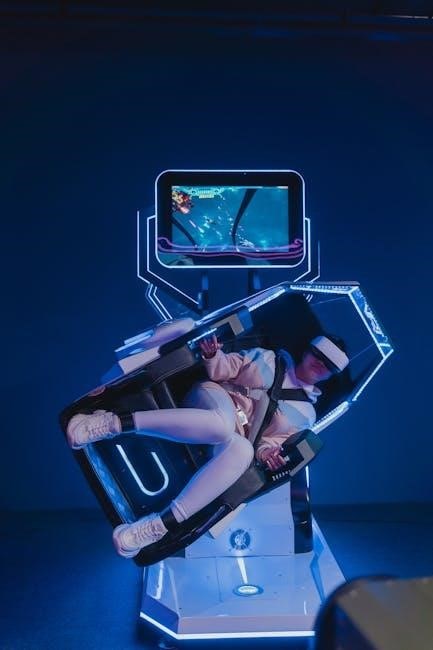Jean Baudrillard’s Simulacra and Simulation explores how modern societies substitute reality with representations․ The PDF delves into hyperreality, where simulations dominate culture, altering human perception of truth․
Overview of Jean Baudrillard’s Theory
Jean Baudrillard’s theory of simulacra and simulation posits that modern society has replaced reality with representations․ He argues that simulations, such as media and consumer culture, create a hyperreal world․ Baudrillard contends that these simulations mask the absence of underlying truth, leading to a detachment from authentic experiences․ His work critiques capitalism and consumerism, emphasizing how symbols and models dominate human perception, creating a reality that is fundamentally constructed rather than natural․
Key Concepts: Simulacra and Simulation
Baudrillard defines simulacra as copies without originals, and simulation as the process of creating these copies․ He identifies four phases of simulacra, from faithful representations to pure simulations․ In hyperreality, simulations replace reality, altering perceptions and interactions․ These concepts explain how media, technology, and consumerism shape modern life, where the distinction between real and artificial dissolves, leaving society deeply embedded in a world of constructed realities and illusions․

The Core Idea of Simulacra
Simulacra are copies without originals, replacing reality with representations․ Baudrillard argues they create a hyperreal experience, detaching society from authentic reality and reshaping perception entirely․
Definition and Evolution of Simulacra
Simulacra, as defined by Baudrillard, are copies without an original, representing a reality that never existed․ They evolve from basic imitations to complex, hyperreal constructs․ Originally, simulacra were simple replicas, but in modernity, they proliferate through media and technology, becoming indistinguishable from reality․ This evolution reflects a shift from tangible representations to abstract, self-referential systems that construct meaning․ Baudrillard’s theory traces this progression, highlighting how simulacra dominate contemporary culture, reshaping human perception and experience․
The Role of Simulation in Modern Society
Simulation in modern society creates a hyperreal reality, where models and representations replace authentic experiences․ Media and technology drive this process, generating illusions that shape culture and daily life․ Simulation influences social interactions, consumer behavior, and political landscapes, often blurring the line between fact and fiction․ Baudrillard argues that simulation dominates contemporary life, constructing a world where the artificial feels more real than reality itself, profoundly impacting how individuals perceive and engage with their surroundings․
The Precession of Simulacra
The precession of simulacra refers to how copies without originals precede and shape reality․ Simulacra now define truth, creating a hyperreal world where the real no longer exists․
Understanding the Concept of Hyperreality
Hyperreality, a term coined by Jean Baudrillard, describes a world where simulations and models of reality replace the real․ These constructs, often mediated through technology and media, create a layer of reality that feels more authentic than reality itself․ In hyperreality, symbols and images shape perceptions, leading to a detachment from tangible experiences․ This concept underscores how modern societies increasingly interact with representations rather than actual events, altering human understanding of truth and reality fundamentally․
How Simulacra Replace Reality
Jean Baudrillard argues that simulacra, or copies without an original, gradually replace genuine reality․ Through media and technology, these reproductions create a hyperreal world where the simulation becomes indistinguishable from reality; Over time, society accepts these constructs as authentic, leading to the erosion of the real․ This process is accelerated by consumer culture, where images and symbols dominate, further disconnecting individuals from tangible experiences and authentic meanings․
Simulation and Its Implications
Simulation reshapes human behavior and perception, creating a world where models and representations dominate․ It challenges authenticity, influencing culture, identity, and social structures profoundly․
From Representation to Simulation
Baudrillard argues that society has shifted from representation, where symbols reflect reality, to simulation, where models and signs replace real-world references․ This transition fosters hyperreality, where simulations are indistinguishable from reality, altering cultural and social dynamics․ The PDF highlights how technology and media accelerate this process, creating a world dominated by artificial constructs rather than authentic experiences․
The Impact of Simulation on Culture
Simulation profoundly influences culture by creating hyperreal experiences that often overshadow reality․ Media, technology, and consumerism propagate these simulations, reshaping cultural values and identities․ The PDF discusses how this shift leads to a society where authenticity is lost, and cultural expressions are reduced to mere spectacle, challenging traditional notions of meaning and truth in a postmodern world․

Critique of Modern Society
Baudrillard critiques modern society for being dominated by images and consumption, where simulacra replace authentic experiences, leading to the erosion of meaning and genuine human connection․
Baudrillard’s View on Capitalism and Consumerism
Baudrillard argues that capitalism and consumerism thrive on simulacra, creating a hyperreal world where commodities replace genuine experiences․ He posits that consumer culture is driven by the endless pursuit of symbolic value, where objects are desired for their signification rather than utility․ This system perpetuates a cycle of desire and dissatisfaction, reinforcing the dominance of simulation over reality․ His critique highlights how capitalism transforms reality into a spectacle of consumption․
The Disappearance of the Symbolic Order
Baudrillard contends that the symbolic order, which once structured society through meaningful signs and symbols, has vanished․ In its place, hyperreality dominated by simulacra erodes authentic symbolic exchange․ This shift results in a world where signs no longer represent reality but instead create a self-referential system․ Consequently, meaning becomes unstable, and social interactions are mediated by simulations that lack a tangible connection to reality, leading to a loss of shared cultural frameworks and understanding․

Simulacra and Media
Media constructs simulacra, shaping perceptions of reality through hyperreal representations․ It propagates simulations that influence cultural norms, creating a world where the virtual overshadows the authentic․
The Role of Media in Creating Simulacra
Media plays a pivotal role in constructing simulacra by disseminating hyperreal images and narratives․ Through advertising, entertainment, and news, it creates illusions that shape cultural perceptions․ Social media amplifies these simulacra, fostering a reality detached from authenticity․ Baudrillard’s theory highlights how media transforms real events into simulations, blurring the line between fact and fiction, and influencing societal beliefs and values profoundly․
Technology and the Hyperreal
Technology accelerates the creation of hyperreality by generating sophisticated simulations․ Digital tools and virtual platforms fabricate immersive experiences, making the hyperreal indistinguishable from reality․ Baudrillard argues that technology reinforces simulacra, enabling the proliferation of models and codes that replace authentic experiences․ This technological mediation deepens societal entrenchment in hyperreality, further detaching individuals from tangible truths and authentic interactions, as digital simulations dominate modern life․
Historical Context of Baudrillard’s Work
Baudrillard’s theory emerged in the late 20th century, reflecting postmodernist thought and critiques of capitalism․ His work was influenced by poststructuralism and societal shifts in technology and culture․
Influence of Postmodernist Thought
Jean Baudrillard’s work was deeply influenced by postmodernist ideas, particularly the skepticism of grand narratives and the fragmentation of reality․ Postmodernism’s emphasis on the constructed nature of reality aligned with Baudrillard’s concepts of simulacra and hyperreality․ His theories reflect a departure from traditional Marxist critiques, instead focusing on the cultural and symbolic dimensions of capitalism․ This intellectual shift positioned Baudrillard as a key figure in postmodern thought, offering new perspectives on consumerism, media, and the dissolution of meaning in modern society․
Intellectual Background and Contributions
Jean Baudrillard’s intellectual journey began with Marxism and sociological studies, later shifting toward poststructuralism and semiotics․ His work challenges traditional notions of reality, introducing concepts like simulacra and hyperreality․ Baudrillard’s contributions lie in redefining cultural theory, emphasizing the dominance of symbols and models over tangible reality․ His theories have profoundly influenced fields such as media studies, sociology, and philosophy, offering new lenses to analyze modernity, consumerism, and the digital age, making him a pivotal thinker in contemporary thought․
Philosophical Influences
Jean Baudrillard’s work draws from Marxism and poststructuralism, with influences from Nietzsche․ His theories critique capitalist systems and explore hyperreality, shifting focus from economic to cultural symbols․
Marxism and Poststructuralism
Jean Baudrillard’s theory of simulacra and simulation is deeply influenced by Marxist critiques of capitalism and poststructuralist ideas․ He extends Marxist concepts of commodification to cultural symbols, arguing that capitalism creates illusions of value․ Drawing from poststructuralists like Foucault and Derrida, Baudrillard challenges rigid notions of truth and power․ His work blends these traditions to critique modern society, where simulations replace material realities, reflecting a shift from production to hyperreality․ This fusion of Marxist and poststructuralist thought defines his unique perspective on culture and power․
Comparisons with Other Theorists
Jean Baudrillard’s work is often compared to other influential thinkers like Michel Foucault and Gilles Deleuze․ While Foucault focused on power structures, Baudrillard emphasized simulation’s role in shaping reality․ Deleuze’s concepts of desire and control resonate with Baudrillard’s hyperreality, where simulations govern social dynamics․ Others, such as Slavoj Žižek, have drawn parallels between Baudrillard’s simulacra and Lacan’s “symbolic order,” highlighting the illusionary nature of contemporary culture․ These comparisons underscore Baudrillard’s unique contribution to postmodern thought;

Implications and Applications
Baudrillard’s theory on simulacra and simulation highlights the pervasive influence of media and technology in shaping reality․ It offers insights into cultural studies, sociology, and digital environments․
Sociological and Cultural Relevance
Jean Baudrillard’s theory of simulacra and simulation offers profound insights into modern culture, emphasizing how societies construct reality through representations․ It critiques consumer culture and media’s role in shaping perceptions, highlighting the erosion of authenticity․ The concept of hyperreality explains how simulations dominate social interactions, influencing identity and power structures․ This framework remains vital for understanding contemporary cultural dynamics and the impact of technology on human experience․
Simulacra in Contemporary Discourse
Baudrillard’s simulacra theory is widely referenced in modern discussions on technology, media, and culture; The concept is used to analyze virtual realities, social media, and digital identities, where simulations often replace authentic experiences․ Contemporary discourse applies Baudrillard’s ideas to understand phenomena like deepfakes, AI-generated content, and the commodification of information․ His work remains a cornerstone in critical theory, offering lenses to critique the hyperreal landscapes shaping today’s globalized and digital world․
Baudrillard’s theory of simulacra and simulation remains pivotal in understanding media, culture, and technology․ Future research could explore its applications in AI and digital ethics, offering new insights․
Relevance of Baudrillard’s Theory Today
Baudrillard’s concepts of simulacra and hyperreality are increasingly relevant in today’s digital age․ Social media, AI, and virtual realities create worlds where simulations often replace authentic experiences․ His ideas help us critique how technology shapes culture and perception, making his work essential for understanding contemporary issues like fake news, digital identity, and the commodification of reality․ This resonance ensures his theory’s enduring influence in various fields․
Further Research and Applications
Baudrillard’s theory of simulacra and simulation continues to inspire research in media studies, sociology, and philosophy․ Scholars explore its relevance to digital media, AI, and virtual reality, examining how simulations shape identity and culture․ Applications include analyzing consumer behavior, political communication, and the impact of technology on reality․ Future studies could focus on interdisciplinary approaches, combining Baudrillard’s ideas with empirical research to address contemporary challenges in hyperreal worlds․

How to Access the PDF
The Simulacra and Simulation PDF is available online through academic platforms and publishers like The University of Michigan Press․ Download options include PDF and text formats․
Availability and Sources
Simulacra and Simulation PDF is accessible through various academic platforms, including The University of Michigan Press and POSTUM Publishing House․ It is also available online for free download in PDF and text formats․ Readers can find it on digital libraries, academic databases, and select online archives․ The PDF is widely distributed, making Baudrillard’s seminal work easily accessible for scholarly and personal use globally․
Reading and Interpreting the Text
Reading Simulacra and Simulation requires critical engagement with Baudrillard’s philosophical ideas․ The text challenges readers to think deeply about hyperreality and its impact on culture․ Interpretation involves understanding how simulacra replace authentic experiences, shaping modern society․ The PDF version allows for easy navigation and reference to key concepts like the precession of simulacra․ Readers are encouraged to cross-reference with other philosophical texts to fully grasp Baudrillard’s postmodernist arguments․
